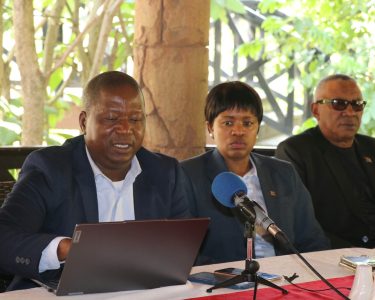By Phephile Motau
Agriculture stakeholders want the government to have flexible legislation to allow them to declare a state of emergency on the fertiliser situation in the country. A state of emergency derives from a governmental declaration made in response to an extraordinary situation posing a fundamental threat to the country. The declaration may suspend certain normal functions of government, may alert citizens to alter their normal behaviour, or may authorise government agencies to implement emergency preparedness plans.

This was said by the Director of Agriculture, Nelson Mavuso, during the Regional Multi-Stakeholder Dialogue on vulnerable farmers’ access to fertilizer themed ‘Sharing innovations, good practices and viable options’ which was held at the Hilton Garden Inn from Tuesday until Friday.
It was hosted by the Food and Agricultural Organisation (FAO) and presentations were made on the impact of the conflict on food systems in the Eastern Western and Southern African regions.
The meeting was aimed at addressing the effects of the Ukraine-Russia conflict which has seen the prices of fertiliser shoot to up to 150 per cent and also affected its availability, therefore leading to a sharp increase in food prices.
Making a presentation on behalf of Eswatini participants after discussions that were held on Tuesday to come up with solutions, Mavuso said amongst the things which were not going so well in Eswatini, was the indecisiveness in declaring a state of emergency. He said they desired that as during the last farming season, they got fake and unknown fertilisers, and farmers did not get the desired benefit.
He said another missed opportunity was what other countries had called bureaucratic processes or a slow decision process and lengthy legislative processes, which needed caution when being dealt with.
According to a study conducted by the FAO titled ‘Assessing the Impact and Vulnerability of the Southern African Development Community (SADC)’s food system to the Russia/Ukraine conflict, before the conflict, fertilizer prices were already elevated, up by an average of 40 per cent to 80 per cent between June and December 2021, compared to the corresponding period in 2020 in various countries in the SADC region. In the first six months of 2022, fertilizer prices further escalated by more than 50 per cent putting a strain on farmers, the small-scale and subsistence farmers.
The global rise in fertilizer prices can be attributed to various factors including the increased demand coinciding with the rise of oil, gas, and other raw materials used to produce fertilizer.
The FAO said as the world regained its activity following the Covid 19 pandemic and opened more economic operations, farmers across the world upscaled their production to meet the growing food demand, thus requiring more inputs and fertilizer.
This caused a surge in fertilizer prices, disadvantaging the import-dependent countries such as those within the SADC region. Potash is one of the crucial fertilizer products in the world. Canada is one of the largest exporters of potash followed by Russia and Belarus. The latter two countries are at the centre of the conflict with Ukraine. In addition to the Russia/Ukraine conflict, the lasting impact of the pandemic, coupled with the impacts of hurricanes in the Southeast which has US production centres have been the main drivers of fertilizer price hikes.
…
Governments need to create an enabling environment for the private sector to set up fertiliser plants.
This is one of the recommendations made by the delegates from different countries during the dialogue.
The delegates who made their presentations on Wednesday morning, representing many countries also suggested that the private sector should also be involved in the input subsidy programmes of the different countries.
Another delegate said there should be an introduction of insurance into the input programmes. A delegate from Zambia explained that in their country, farmers contributed a small amount to the insurance and the government also contributed something. The insurance covers the farmers against drought, floods, and poor harvest.
The farmers were also encouraged to make use of conservation agriculture (CA) and use indigenous products to make organic fertiliser.
Eswatini had a chance to showcase the CA practised at Motshane Primary School where a teacher explained that he approached the regional development area (RDA) after they had seen that they could not afford fertiliser.
The teacher explained that previously, they used 75 kg of inorganic fertiliser, but this current season, they only used 25 kg, which is half a bag.
He said the next year, they would only have to use cow manure for ploughing their fields.
Some other recommendations:
- Enhance weather forecasts and strengthen early warning systems
- Include women and youth in the value chain
- Countries should establish their own fertiliser production facilities
- Provide finance for organic fertiliser manufacturing
- Bulk buying of fertiliser, including through cooperatives
- Invest in improving the knowledge of farmers on the available fertiliser products or alternatives as part of corporate social responsibility






